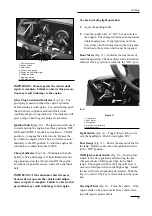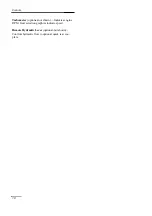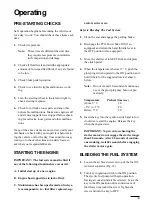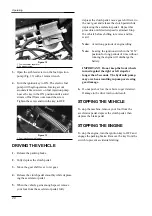
F. Avoid sudden stops and starts. Do not go
from reverse to forward or forward to
reverse without first coming to a complete
stop.
G. Do not attempt sharp turns or abrupt maneu-
vers or other unsafe driving actions that may
cause a loss of vehicle control.
H. When dumping, do not let anyone stand
behind vehicle and do not dump load on any
one’s feet. Release tailgate latches from side
of box, not from behind.
I.
Before backing up, look to the rear and
assure no one is behind. Back up slowly.
J. Watch out for traffic when near or crossing
roads. Always yield the right of way to
pedestrians and other vehicles. This vehicle
is not designed for use on streets or high-
ways. Always signal your turns or stop early
enough so other persons know what you plan
to do. Obey all traffic rules and regulations.
K. Never operate vehicle in or near an area
where there is dust or fumes in the air which
are explosive. The electrical and exhaust sys-
tems of the vehicle can produce sparks capa-
ble of igniting explosive materials.
L. Always watch out for and avoid low over
hangs such as tree limbs, door jambs, over
head walkways, etc. Make sure there is
enough room over head to easily clear the
vehicle and your head.
M. If ever unsure about safe operation, STOP
WORK and ask your supervisor.
19. Do not touch engine, transaxle, radiator, muffler
or muffler shield while engine is running or soon
after it has stopped because these areas may be
hot enough to cause burns.
20. If the machine ever vibrates abnormally, stop
immediately, turn engine off, wait for all motion
to stop and inspect for damage. Repair all dam-
age before commencing operation.
21. Before getting off the seat:
A. Stop movement of the machine.
B. Lower bed.
C. Shut engine off and wait for all movement to
stop.
D. Set the parking brake.
E. Remove key from ignition.
F. Block wheels if machine is on an incline.
MAINTENANCE
22. Before servicing or making adjustments to the
machine, stop engine, set the parking brake and
remove key from ignition to prevent accidental
starting of the engine.
23. Never work under a raised bed without placing
bed safety support on fully extended cylinder
rod.
24. Make sure all hydraulic line connectors are tight,
and all hydraulic hoses and lines are in good
condition before applying pressure to the system.
25. Keep body and hands away from pin hole leaks
or nozzles that eject hydraulic fluid under high
pressure. Use paper or cardboard, not hands, to
search for leaks. Hydraulic fluid escaping under
pressure can have sufficient force to penetrate
skin and do serious damage. If fluid is injected
into the skin it must be surgically removed with-
in a few hours by a doctor familiar with this
form of injury or gangrene may result.
26. Before disconnecting or performing any work on
the hydraulic system, all pressure in system must
be relieved by stopping engine, cycling dump
valve from raise to lower and/or lowering box
and attachments. Place the remote hydraulics
lever in the float position. If box must be in
raised position, secure with safety support.
27. To make sure entire machine is in good condi-
5
Safety






































